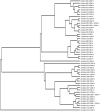Shape and Size Adaptations of Planthoppers Along an Altitudinal Gradient on Mount Wilhelm (Papua New Guinea)
- PMID: 40529336
- PMCID: PMC12171995
- DOI: 10.1002/ece3.71479
Shape and Size Adaptations of Planthoppers Along an Altitudinal Gradient on Mount Wilhelm (Papua New Guinea)
Abstract
Mountains are an ideal context to study species community and adaptation in relation to environmental changes such as temperature and vegetation profile. Such changes produce different ecological niches that can be a source of local adaptations in the communities, like body size varying with elevation, for example. In this context, planthoppers (Insects, Hempitera, Fulgoromorpha) community and their species traits were studied along an altitudinal gradient in Mount Wilhelm (Papua New Guinea) to test niche and morphological trait conservatism in relation to environmental filtering. Niche conservatism is significant at high altitude for Cixiidae, and forewing shape is conserved. This is not the case for Achilidae and Derbidae, for which forewing shape is not conserved and forewing relative length increases in size with altitude. These variations in size and shape translate an adaptation of Achilidae and Derbidae to high altitudes; while closely related species of Cixiidae tend to keep the same ecological niche, and then, forewing size and shape are maintained.
Keywords: Fulgoromorpha; elevational gradient; environmental filtering; morphometric analysis; niche conservatism; phylogeny.
© 2025 The Author(s). Ecology and Evolution published by British Ecological Society and John Wiley & Sons Ltd.
Conflict of interest statement
The corresponding author declares on behalf of all authors that they have no competing or conflicting interest.
Figures



References
-
- Adams, D. C. , and Otárola‐Castillo E.. 2013. “Geomorph: An R Package for the Collection and Analysis of Geometric Morphometric Shape Data.” Methods in Ecology and Evolution 4, no. 4: 393–399. 10.1111/2041-210X.12035. - DOI
-
- Asche, M. 2015. “The West Palaearctic Achilidae (Hemiptera, Fulgoromorpha: Fulgoroidea)—A Review With Description of Five New Species From the Mediterranean.” Nova Supplementa Entomologica 25: 1–135.
-
- Attié, M. , Bourgoin T., Veslot J., and Soulier‐Perkins A.. 2008. “Patterns of Trophic Relationships Between Planthoppers (Hemiptera: Fulgoromorpha) and Their Host Plants on the Mascarene Islands.” Journal of Natural History 42: 1591–1638.
-
- Blomberg, S. P. , Garland T., and Ives A. R.. 2003. “Testing for Phylogenetic Signal in Comparative Data: Behavioral Traits Are More Labile.” Evolution 57, no. 4: 717–745. - PubMed
Associated data
LinkOut - more resources
Full Text Sources

